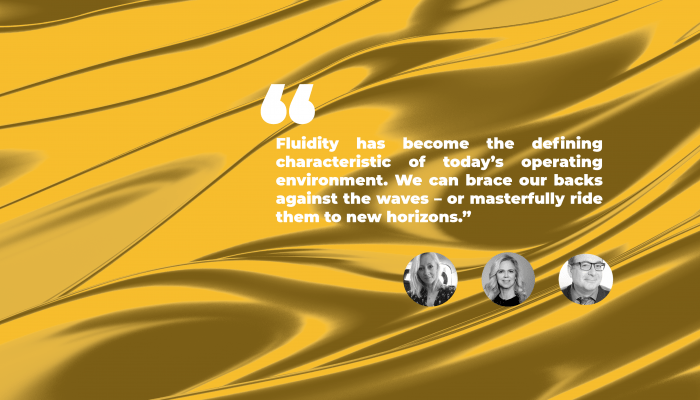Communications Planning 2022 – Harnessing fluidity
It`s this time of the year, when business leaders, brand and communication strategists develop and submit their plans for the next fiscal year. The standard expectation as always: Show us some growth, lead our category, protect our license to operate.
Though, it feels different these days. Imagine you are crossing the Atlantic Ocean on a sail ship. You have plotted your course, but your departure is delayed; wind and weather are changing your navigation plans constantly, the unforeseen is taking over, your usual instruments are failing you. It seems, that ‘fluidity’ has become the defining characteristic of today`s operating environment – inside the organization, its micro-environment and its macro-environment. We have all been dealing with pandemic induced disruption, digitalization, shifting geopolitics, ESG risk management, growing stakeholder scrutiny, a bigger thirst for consumer and employee engagement, budget revisions like a conveyer belt, and the general tilt towards short-termed performance marketing.
My fluid colleagues Mitch Markson, a global creative director, and Lisa Collin, an international strategist and I have been involved in business and communications planning for over 30 years. Over the years we have been hired to ground strategies, ideas and programs in a more or less reliable foundation. We have been in the driver seats, crafting narratives, planning action and words, evolving and innovating platforms, building on previous years’ successes, creating bigger ideas and ensuring plans can be operationalized effectively to reap the benefits. Sometimes, we had to revise plans quarterly, adjust programs based on performance and feed-back, sometimes competitors surprised clients with bigger ideas or faster attacks. We were there to help outsmart them, if we couldn`t outspend them. All in all, a couple of invariables in an otherwise linear context.
A new course between Harbour and Horizon
We are embarking on a different journey today.
Today we work in partnership to bring relevance to brands in an uncertain landscape – defining plans that are able to flex yet remain relevant in this fluid context. Our conversations are about brands’ reason to exist, about a bigger transformation of rules and behaviors, paradigm shifts, reimagining contributions and ensuring organizations have stability and authenticity from which to build.
We have developed a new planning process, called ‘harbour and horizon’, which helps brands harness fluidity. This process is agnostic to the usual organizational functions and siloes. Whether the conversation is started by communications, brand marketing or employee engagement leaders, does not matter: the willingness to collaborate and align is essential to define harbour, horizon and course with unequivocal clarity. Vanity, particular interests and siloes only weaken the endeavour. The process always starts with asking the right questions and using all the available information to identify the current position, opportunities and needs. We map the critical foreseeable factors and anticipate those unspecified factors affecting the course. We go back and forth between the brand’s safe harbour – its heritage, values, DNA – and the brand`s horizon, the aspiration which promises relief (health and survival) and prosperity (growth and wealth) for the brand and the world around it. Both, harbour and horizon, if well defined, form a shield against unforeseen threats, keep brands relevant and even creates greater resilience in the waves of fluidity. The teams navigating this process are asked to be bolder than before yet cautious and sensitive to conflicting developments. They need to gather pace, add value and collaborate more openly from a global mindset.
Some key principles for planning in a fluid environment
- Map, interrogate and confirm your safe harbour – your heritage, your purpose, and your values. Be aligned on the foundation, on everything that`s a non-negotiable, as you cannot re-invent history.
- Strive for clarity when you define the horizon. What do you want to achieve? Have a shared view on your strategic intent, and then break it down into the details of how future will look like for the brand, its main stakeholders and the people who will deliver.
- Think the unthinkable – before others do that for you. What if… is a great discussion starter to broaden our thinking and our conversations before we adapt ourselves to what we believe is feasible.
- Create a powerful proposition, but don`t stop there. A brand needs a global ecosystem with allies as powerful as you are, and a global purpose bigger than your business. What do you want people around you to add?
- Be generous, not frugal in bringing in more than the usual suspects into the planning process. Share control to unlock intelligence from different sources. Collaborate from a divers and global mindset and thus broaden your horizon.
- Prepare more, not less. If circumstances can change by the minute, it might seem ineffective to prepare. The opposite is true. Stress-test your thinking in scenarios.
- Consider how your plans will become real within your organization and become meaningful for your diverse audiences.
- Be open to throw your plans overboard or adjust as the environment dictates. Be open to new possibilities.
Turning a threat into a opportunity
I found it very exciting to craft a more fluid planning process together with Lisa and Mitch. We worked together in different constellations for brands across the globe for many years. Today’s opportunities to collaborate between clients and consultants have become more direct, agile and impactful. We love that. Together, we want to work with client teams to harness that fluidity, not just deal with it. Turning what could be seen as a threat into an opportunity, is the essence of the ambition we are pursuing. If we need additional experts from specific geographies, crafts or industry sectors, our fluid collective of senior advisors from around the world is a phone call away. The whole planning processes happens in collaboration with the client teams. No consultancy black box. We bring in our experiences in real time, with the nice side effect, that client teams learn and grow with the experience. We like to think of us as the hired crew, staying on board as long as we`re needed. And moving on when the ship owners decide to go by themselves or with other teams.


